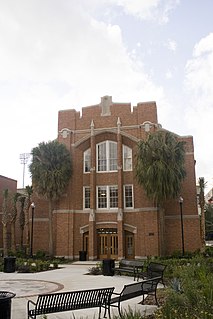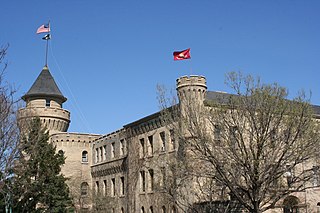
The University of Idaho is a public land-grant research university in Moscow, Idaho. It is the state's land-grant and primary research university, and the lead university in the Idaho Space Grant Consortium. The University of Idaho was the state's sole university for 71 years, until 1963, and its College of Law, established in 1909, was first accredited by the American Bar Association in 1925.

The Kenney Gym and the Kenney Gym Annex are two buildings located at 1402-06 Springfield Avenue in Urbana, Illinois, on the campus on the University of Illinois at Urbana-Champaign. Although the two buildings have been physically connected since 1914, they were built separately. They were jointly added to the National Register of Historic Places in 1986 under the name Military Drill Hall and Men's Gymnasium.

Dillon Gymnasium is an on-campus multi-purpose athletic facility on the campus of Princeton University in Princeton, New Jersey. It was built in 1947 to replace University Gymnasium, which had burned to the ground in 1944. It houses a 1,500-seat gymnasium, squash courts and a pool.

Kathryn Chicone Ustler Hall is a historic building on the campus of the University of Florida (UF) in Gainesville, Florida. It was designed by William Augustus Edwards in the Collegiate Gothic style and opened in 1919 as the University Gymnasium. In that capacity, the building was the first home of the Florida Gators men's basketball team, and it continued to serve as the home court for most of the university's indoor sports programs until the Florida Gymnasium opened in the late 1940s. The university became co-educational at about the same time, and the building was rechristened the Women's Gymnasium and was repurposed as a recreation center for the school's many new female students. On June 27, 1979, it was added to the U.S. National Register of Historic Places.

Memorial Gymnasium is a 2,500-seat multi-purpose arena in Charlottesville, Virginia. It opened in 1924. It replaced Fayerweather Gymnasium as home to the University of Virginia Cavaliers basketball team until University Hall opened in 1965.

Herron Gymnasium was a gymnasium and classroom building on the Miami University campus in Oxford, Ohio. Later known as Van Voorhis Hall, it was listed in the National Register of Historic Places in November 1979. Originally conceived in 1893, it was constructed in 1897 and named for John W. Herron, a Miami alumnus and Cincinnati judge. It was Miami University's first gymnasium, and would serve as the main recreational center until the construction of Withrow Court in 1932, which led Herron to become a women's gym. Except for an interlude during World War II when it served as a Navy barracks, it served as a women's gym until the construction of "New Herron" in 1962. In the late 20th century its use diminished to AFROTC and men's intramural sports, and the gymnasium was demolished in 1986 and replaced with a parking lot.

The University of Wisconsin Armory and Gymnasium, also called "the Red Gym", is a building on the campus of University of Wisconsin–Madison. It was originally used as a combination gymnasium and armory beginning in 1894. Designed in the Romanesque revival style, it resembles a red brick castle. It is situated on the shores of Lake Mendota, overlooking Library Mall, and adjacent to Memorial Union.

The University of Minnesota Armory is a building on the University of Minnesota campus in Minneapolis, Minnesota. The Armory was constructed in 1896 after the previous space for military training on the campus burnt in a fire in 1894. The facility served as the primary home for the Minnesota Golden Gophers men's basketball team as well as the University of Minnesota Marching Band after its construction. The basketball team moved to the Kenwood Armory in Downtown Minneapolis in 1925 while the band moved to the newly completed Music Education Building in 1922. Fielding H. Yost, Michigan Wolverines football coach, forgot the Little Brown Jug, one of the oldest college football traveling trophies, in the locker rooms of the Armory in 1903. The Armory was also the facility used for the University of Minnesota physical education department until 1935. The school's football team played some of their early games on the open field next to the Armory.

The Detroit Naval Armory is located at 7600 East Jefferson Avenue in Detroit, Michigan. It is also known as the R. Thornton Brodhead Armory. The armory was designated a Michigan State Historic Site in 1980 and listed on the National Register of Historic Places in 1994.

Bear Down Gym, originally known as Men's Gymnasium, is a 300-seat multi-purpose arena in Tucson, Arizona. It opened in 1926. It was home to the University of Arizona Wildcats basketball team. It was replaced when the McKale Center opened in 1973. It is listed on the National Register of Historic Places.

John Everett Tourtellotte was a prominent western American architect, best known for his projects in Idaho. His work in Boise included the Idaho State Capitol, the Boise City National Bank, the Carnegie Library, and numerous other buildings for schools, universities, churches, and government institutions. From 1922 to 1930, he worked in Portland, Oregon.

War Memorial Gymnasium is a 2,500-seat multi-purpose indoor arena in the northwest United States, on the campus of the University of Idaho in Moscow, Idaho. Opened 94 years ago in November 1928, the venue honors state residents who gave their lives in the service of their country in World War I.

The 14th Regiment Armory, also known as the Eighth Avenue Armory and the Park Slope Armory, is a historic National Guard armory building located on Eighth Avenue between 14th and 15th Streets in the South Slope neighborhood of Brooklyn, New York City, United States. The building is a brick and stone castle-like structure, and designed to be reminiscent of medieval military structures in Europe. It was built in 1891–95 and was designed in the Late Victorian style by William A. Mundell.

The Health Education Building, also known as the McAfee Gym, is a historic building located on the campus of Eastern Illinois University in Charleston, Illinois. The building was constructed in 1938 and designed by Peoria architecture firm Hewitt, Emerson and Greg; C. Herrick Hammond served as the state's supervising architect on the project. The building's design incorporates elements of several contemporary architectural styles; it features an Art Deco octagonal clock tower and projecting pilasters, while its flat roof and concrete coursing are representative of the Art Moderne style and its steel ribbon windows are inspired by the International Style. The university used the new building to expand its physical education program into a full course of study, which included the establishment of a women's physical education program. The building was also used to host sporting events, student performances, and school dances. In the 1960s, the construction of Lantz Arena and a new classroom building for health education resulted in the relocation of many of the programs held in the building. The building was officially renamed the Florence McAfee Women's Gymnasium in 1965, after the first head of women's athletics at the university.

32nd St. and Lancaster Ave. Philadelphia Armory, also known as the 32nd Street Armory or Drexel Armory, is a historic National Guard armory and multipurpose venue located in the University City neighborhood of Philadelphia, Pennsylvania. Main entrances to the Armory are located at both 33rd and Cuthbert Street, and along Lancaster Walk. Cuthbert Street is part of the Armory property and was removed from Philadelphia city street listing. It was built in 1916, and is a trapezoidal shaped building in the Classical Revival style. It is a three-story, 21,346 square foot, brick building with stone entablature and parapet. It houses administrative offices, a gymnasium, and drill hall. It was added to the National Register of Historic Places in 1991.

Old Gym is one of the surviving Victorian buildings that characterized the early style of the Vanderbilt University campus in Nashville, Tennessee. The Old Gym was originally a gymnasium, later served as the Fine Arts Building, and currently houses the university's admissions office.

The New Providence School Gymnasium, also known as the New Providence Roundhouse, is a historic building located in New Providence, Iowa, United States. The gym was built between 1935 and 1936 as a Public Works Administration (PWA) project. It was one of 32 PWA school buildings designed by the Des Moines architectural firm of Keffer-Jones, and built by J.E. Lovejoy Construction Company, also of Des Moines. The most notable feature of the building is that it is round, and it is believed that it is the first round building that was built specifically as a gymnasium in the state of Iowa. The building hosted many basketball tournaments, and was used for graduation exercises, sporting, musical, dramatic, and community events. It was part of the local school for 50 years, and it is now used as a community center. The building was listed on the National Register of Historic Places in 1996.

The Idaho National Guard Armory in Boise, Idaho, is an unreinforced, poured concrete building designed by Tourtellotte & Hummel and constructed in three phases beginning with a 1-story section in 1931. The building includes a drill hall large enough for equestrian events and a 2-story office area completed in 1956. The facade is minimally decorated and features Art Deco elements, including a cornice of stepped concrete bands, projecting pilasters, and zigzag patterning.
The 1927–28 Idaho Vandals men's basketball team represented the University of Idaho during the 1927–28 NCAA college basketball season. Members of the Pacific Coast Conference, the Vandals were led by first-year head coach Rich Fox and played their home games on campus at the Armory and Gymnasium in Moscow, Idaho.
The 1926–27 Idaho Vandals men's basketball team represented the University of Idaho during the 1926–27 NCAA college basketball season. Members of the Pacific Coast Conference, the Vandals were led by seventh-year head coach Dave MacMillan and played their home games on campus at the Armory and Gymnasium in Moscow, Idaho.



















